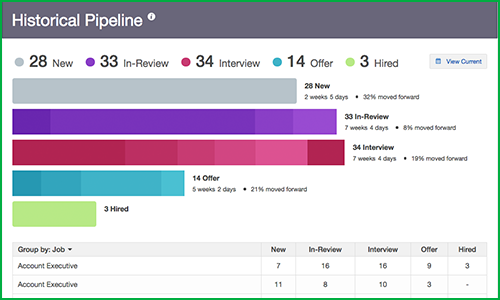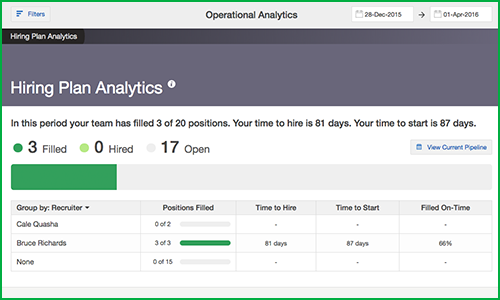HR has made great strides in getting a “seat at the table”. Why? One reason is that CEOs consistently rank finding top talent as critical to the future of their businesses. They need a strong business partner “at the table” to drive the company recruiting agenda. But having a seat at the table means knowing your success numbers in the same way sales, marketing, and finance leaders do.
While more sophisticated talent acquisition departments may have hundreds of reports around recruiting – along with the business intelligence tools and analysts to support them – they tend to be the minority. So to help the rest of you get that coveted “seat at the table”, here are three key metrics that will link your recruiting work to the bottom line, and give CEOs a stronger reason to invest in your TA department.
1. Sourcing Metrics
A company’s recruiting budget is usually spent on headcount first followed by sourcing and marketing tools, channels, and programs. Candidate sourcing and recruitment marketing is a decent chunk of anyone’s recruiting budget.
Because you’re spending a lot, you need to understand the effectiveness of each of the channels you’re using: your company career site, job boards, LinkedIn Recruiter seats, niche sites, referrals, alumni networks, etc. You need to understand how these channels work for what types of jobs and locations so you can optimize your budget accordingly.

Sadly, this can be a hassle for companies as they hustle to manually cobble together data from multiple systems each year. This is all just to see what worked and then plan accordingly for the next 12 months. Unfortunately, this is not agile enough to be effective. In other words, you’re wasting money – maybe a lot of money – by blindly investing your advertising dollars until you get to see how it worked at the next anniversary of your reporting cycle. Our data science team has this data across over 750 SmartRecruiters customers – and you’d be surprised by the results. Millions and millions of dollars are wasted every year on sourcing and advertising that was never going to perform well in the first place.
Alternatively, when you have a recruiting software platform that is connected to all of your candidate sourcing and recruitment marketing channels combined with hiring teams using a consistent, quantifiable candidate scoring model (like a 5 star rating system), you can now measure both the volume of candidates entering the top of your funnel and the quality of those candidates. And by having access to that information in real time there’s no more wasted budget.
2. Pipeline Metrics
These metrics tell you how well your process is working: what’s the throughput in your hiring process? What are your conversion percentages from one stage to the next, and how long does each stage take? You’ll also want to see this data divided by department, division, location, hiring manager, recruiter, etc. For example, if you have a stage in your hiring process where you hand the candidate off to a hiring manager to review, it’s important to know if those candidates sit in that stage for too long. If so, it can unnecessarily slow down your process and make you less competitive in the market.

With this information, you can start to implement and measure an SLA across hiring teams. The trick, of course, is to make sure that all stakeholders in the hiring process – recruiters, interviewers, and hiring managers – have access to the applicant tracking system (ATS) to provide their feedback. You’ll also want your ATS to be intuitive and simple to use. Why would you want a cumbersome interface to become a burden on the user (or on your training team)? Without that, you end up where many are today: with what I call “zero days to fill” syndrome – the actual hiring process happens outside your system, via excel and email, where it can’t be measured.
3. Hiring Plan Metrics
These metrics tell you how well you are doing against a forecasted, budgeted hiring plan. Are you meeting the hiring goals set forth by the business, and are you reaching those on time?
An overall time-to-fill number is interesting, but it doesn’t tell the whole story. The key is to properly forecast how long it will take to hire someone in the first place. Ultimately, harder to fill roles naturally take longer. You’ll need to understand when your company needs those people in place in order to meet the business objectives. This is what the CEO and CFO want to know because this is precisely where revenue intersects with recruiting execution. When positions go unfilled for longer than forecasted, teams tend to go out to staffing agencies where expensive placement fees are paid (and it’s hard to justify a TA function when most filled jobs come with hefty placement fees).

However, there is a real cost to the productivity of the business; take your revenue per employee per day (total revenue divided by the number of employees divided by 260 working days in a year) and then multiply that times the number of days past the due date for that new hire and you start to see the impact. Let’s use an example of a company with 1,000 new hires a year and $250,000 in annual revenue per employee. If that company only hits it’s hiring plan on time 50% of the time, and misses it on average by 5 days, the loss of productivity/revenue to the business is $2.4M. If that same company hits the hiring plan goals 75% of the time they pick up another $1.2M in productivity/revenue. That’s a lot of money!

This is also a great metric to help recruiting leaders show ROI for their initiatives and programs, as long as you can demonstrate how and what you need funded to move the needle.
There are endless metrics in any business, but oftentimes it helps to boil it down to just a few. Understanding WHERE we find the best people, how efficiently we PROCESS those people through our pipeline, and whether we are meeting the demands of the business by hiring the talent they need ON TIME tells us quite a bit about how well our talent acquisition function is performing. It also gives us a good idea of where we need to improve it going forward.
If you’re interested in learning more and taking a look at some of the industry benchmark data around these three metrics, contact us here.










